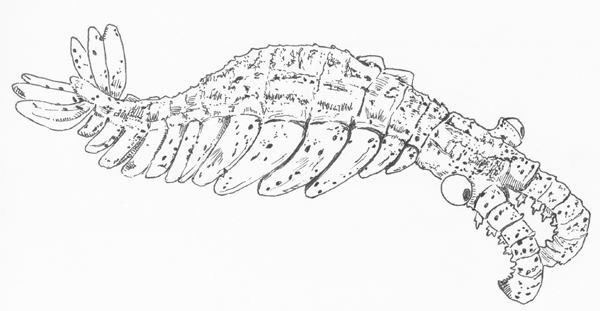Sophisticated Compound Eye with 3,000 Individual Lenses in 515 Million Year Old Fossil
Trilobites may have had some of the earliest recorded eyes in the fossil record, but 515 million years ago, there was a sharp-eyed predator that probably preyed on trilobites and its eyes were the most complex and sophisticated known from the Cambrian Period.
Eye Fossil
The eyes of trilobites are compound eyes, as seen in other arthropods today such as flies and other insects. Each eye had many lenses and each lens provided an image of the world, the more lenses the better the impression of the surroundings. The trilobite lens was made of calcite and the preservation potential of these lenses were as good as the rest of the exoskeleton, which was also made of calcite.
However, the eyes of trilobites from 515 million years ago are not a patch on the fossil eyes of as yet unknown arthropod that have been discovered on Kangaroo Island, South Australia.
Mike Lee, an evolutionary biologist who is leading the joint South Australian Museum and Adelaide University fossil study commented that the researchers were unsure at this stage what sort of creature had these advanced eyes, but they speculate it was a predator.
Dr Lee stated:
“This particular animal had by far the most powerful vision of its time. These fossils are absolutely unique because no other fossil site in the world has produced eyes of this complexity.”
As details of the research are published in the scientific journal “Nature” other scientists can learn a little more about the Australian team’s studies of the fauna of a Cambrian marine environment. A spokesperson for Everything Dinosaur agreed with the initial findings that the eye fossils probably belonged to a predator.
“It is a fair assumption that these eyes belonged to a predatory arthropod of some sort, perhaps some kind of large shrimp-like creature. Firstly the eyes are very sophisticated and good vision would have been extremely useful for an animal that hunted. In addition, at over 1 cm in diameter, the eyes are big so they probably belonged to a big animal and in the Late Cambrian predators were generally larger than prey.”
Could the fossil eyes belong to an arthropod similar to an Anomalocaris, a fearsome predator of the Middle Cambrian, whose kith and kin survived into the Ordovician.
A Drawing of an Anomalocaris
Picture credit: Everything Dinosaur
To read about giant Anomalocarids of the Ordovician: Anomalocarids – Bigger than Previously Thought.
Dr Lee said other specimens from the Emu Bay site (Kangaroo Island) had vision equivalent to about 100 pixels, allowing them to differentiate between light and dark and perhaps pick out shapes and movement. However, these particular eyes had the equivalent of more than 3,000 pixels, or about 3,000 individual calcite lenses, making this vision system as sophisticated as that of modern prawns.
Dr Lee went on to add:
“With 3000 pixels, you can start to tell friend from foe.”
The strata in which these fossils were found dates to around 515 million years ago (Late Cambrian). Around 545 million years ago, one of the most significant events in the history of life on our planet occurred. There was a sudden burst of evolution, resulting in the rapid expansion and diversification of organisms (as recorded in the fossil record). A wide variety of creatures, especially those with hard, mineralised shells and other body parts suddenly appeared. Within a few million years, most of the animal Phyla that are in existence today had evolved.
Quite why there was this sudden burst of evolution referred to as the “Cambrian Explosion” remains unknown. However, scientists have suggested that the evolution of an “arms race” between predator and prey may have led to this considerable advance in life on planet Earth. Certainly, whatever sort of creature had eyes with 3,000 pixels is a testament to speed of evolution in the Cambrian Period.
Pictures show a beautifully preserved compound eye, the individual lenses can just be made out in the photograph.
The new fossils reveal that some of the earliest known arthropods had already acquired visual systems similar to those of living forms, underscoring the speed and magnitude of the evolutionary innovation that occurred during the Cambrian Explosion, the researchers conclude. As the eyes were found isolated, researchers can’t say with certainty what sort of animal had them. But the fossils were found in the same rock as an array of ancient marine animals, providing the scientists with an impression of what the environment and ecosystem was like for this particularly advanced animal.
With 3,000 pixels, the newly discovered ancient animals would have seen three times better than the modern horseshoe crab. But its eyesight would have paled in comparison to the modern dragonfly, a few of which have been emerging from our office pond over the last weeks. Extant dragonflies have over 28,000 lenses in each eye.
To view replicas of prehistoric animals like Anomalocaris and trilobites: CollectA Age of Dinosaurs Popular Model Range.







i once had a dream i was that old and woke up in a spill of oil. maybe that wasn't the right date at all
the earliest known eyes, 500+ million years, are as specialized and complex as any modern eyes and needed brains complex enough to process the data. In fact some almost identical to some modern eyes (see: stomatopods). Instant complexity and specialization. 500 million years of stasis (see: stomatopods). Yet only incredibly slow and gradual change is allowed to explain it, the observable be damned. Bizarrewinism.